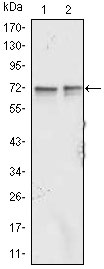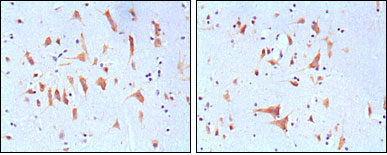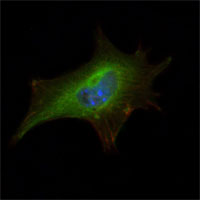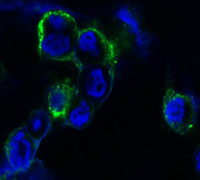FMR1 Antibody
Purified Mouse Monoclonal Antibody
- SPECIFICATION
- CITATIONS
- PROTOCOLS
- BACKGROUND

Application
| WB, IHC, ICC, E |
|---|---|
| Primary Accession | Q06787 |
| Reactivity | Human |
| Host | Mouse |
| Clonality | Monoclonal |
| Clone Names | 4G9 |
| Isotype | IgG1 |
| Calculated MW | 71kDa |
| Description | FMR1, also known as POF, FMRP, FRAXA. Entrez Protein: NP_002015. It is an RNA-binding protein that associates with polyribosomes and is a likely component of a messenger ribonuclear protein (mRNP) particle The protein may be involved in mRNA trafficking from the nucleus to the cytoplasm. A trinucleotide repeat (CGG) in the 5' UTR is normally found at 6-53 copies, but an expansion to 55-230 repeats is the cause of fragile X syndrome. Expansion of the trinucleotide repeat may also cause one form of premature ovarian failure (POF1). RNA-binding protein that plays a role in intracellular RNA transport and in the regulation of translation of target mRNAs. |
| Immunogen | Purified recombinant fragment of human FMR1 expressed in E. Coli. |
| Formulation | Ascitic fluid containing 0.03% sodium azide. |
| Gene ID | 2332 |
|---|---|
| Other Names | Fragile X mental retardation protein 1, FMRP, Protein FMR-1, FMR1 |
| Dilution | WB~~1/500 - 1/2000 IHC~~1/200 - 1/1000 IF~~1/200 - 1/1000 ICC~~1:200~~1000 |
| Storage | Maintain refrigerated at 2-8°C for up to 6 months. For long term storage store at -20°C in small aliquots to prevent freeze-thaw cycles. |
| Precautions | FMR1 Antibody is for research use only and not for use in diagnostic or therapeutic procedures. |
| Name | FMR1 {ECO:0000303|PubMed:8504300, ECO:0000312|HGNC:HGNC:3775} |
|---|---|
| Function | Multifunctional polyribosome-associated RNA-binding protein that plays a central role in neuronal development and synaptic plasticity through the regulation of alternative mRNA splicing, mRNA stability, mRNA dendritic transport and postsynaptic local protein synthesis of target mRNAs (PubMed:12417522, PubMed:16631377, PubMed:18653529, PubMed:19166269, PubMed:23235829, PubMed:25464849). Acts as an mRNA regulator by mediating formation of some phase- separated membraneless compartment: undergoes liquid-liquid phase separation upon binding to target mRNAs, leading to assemble mRNAs into cytoplasmic ribonucleoprotein granules that concentrate mRNAs with associated regulatory factors (PubMed:12417522, PubMed:30765518, PubMed:31439799). Plays a role in the alternative splicing of its own mRNA (PubMed:18653529). Stabilizes the scaffolding postsynaptic density protein DLG4/PSD-95 and the myelin basic protein (MBP) mRNAs in hippocampal neurons and glial cells, respectively; this stabilization is further increased in response to metabotropic glutamate receptor (mGluR) stimulation (By similarity). Plays a role in selective delivery of a subset of dendritic mRNAs to synaptic sites in response to mGluR activation in a kinesin-dependent manner (By similarity). Undergoes liquid-liquid phase separation following phosphorylation and interaction with CAPRIN1, promoting formation of cytoplasmic ribonucleoprotein granules that concentrate mRNAs with factors that inhibit translation and mediate deadenylation of target mRNAs (PubMed:31439799). Acts as a repressor of mRNA translation in synaptic regions by mediating formation of neuronal ribonucleoprotein granules and promoting recruitmtent of EIF4EBP2 (PubMed:30765518). Plays a role as a repressor of mRNA translation during the transport of dendritic mRNAs to postsynaptic dendritic spines (PubMed:11532944, PubMed:11157796, PubMed:12594214, PubMed:23235829). Component of the CYFIP1-EIF4E-FMR1 complex which blocks cap-dependent mRNA translation initiation (By similarity). Represses mRNA translation by stalling ribosomal translocation during elongation (By similarity). Reports are contradictory with regards to its ability to mediate translation inhibition of MBP mRNA in oligodendrocytes (PubMed:23891804). Also involved in the recruitment of the RNA helicase MOV10 to a subset of mRNAs and hence regulates microRNA (miRNA)-mediated translational repression by AGO2 (PubMed:14703574, PubMed:17057366, PubMed:25464849). Facilitates the assembly of miRNAs on specific target mRNAs (PubMed:17057366). Also plays a role as an activator of mRNA translation of a subset of dendritic mRNAs at synapses (PubMed:19097999, PubMed:19166269). In response to mGluR stimulation, FMR1-target mRNAs are rapidly derepressed, allowing for local translation at synapses (By similarity). Binds to a large subset of dendritic mRNAs that encode a myriad of proteins involved in pre- and postsynaptic functions (PubMed:7692601, PubMed:11719189, PubMed:11157796, PubMed:12594214, PubMed:17417632, PubMed:23235829, PubMed:24448548). Binds to 5'-ACU[GU]-3' and/or 5'-[AU]GGA-3' RNA consensus sequences within mRNA targets, mainly at coding sequence (CDS) and 3'-untranslated region (UTR) and less frequently at 5'-UTR (PubMed:23235829). Binds to intramolecular G-quadruplex structures in the 5'- or 3'-UTRs of mRNA targets (PubMed:11719189, PubMed:18579868, PubMed:25464849, PubMed:25692235). Binds to G-quadruplex structures in the 3'-UTR of its own mRNA (PubMed:7692601, PubMed:11532944, PubMed:12594214, PubMed:15282548, PubMed:18653529). Binds also to RNA ligands harboring a kissing complex (kc) structure; this binding may mediate the association of FMR1 with polyribosomes (PubMed:15805463). Binds mRNAs containing U-rich target sequences (PubMed:12927206). Binds to a triple stem-loop RNA structure, called Sod1 stem loop interacting with FMRP (SoSLIP), in the 5'-UTR region of superoxide dismutase SOD1 mRNA (PubMed:19166269). Binds to the dendritic, small non-coding brain cytoplasmic RNA 1 (BC1); which may increase the association of the CYFIP1-EIF4E-FMR1 complex to FMR1 target mRNAs at synapses (By similarity). Plays a role in mRNA nuclear export (PubMed:31753916). Specifically recognizes and binds a subset of N6-methyladenosine (m6A)- containing mRNAs, promoting their nuclear export in a XPO1/CRM1- dependent manner (PubMed:31753916). Together with export factor NXF2, is involved in the regulation of the NXF1 mRNA stability in neurons (By similarity). Associates with export factor NXF1 mRNA-containing ribonucleoprotein particles (mRNPs) in a NXF2-dependent manner (By similarity). Binds to a subset of miRNAs in the brain (PubMed:14703574, PubMed:17057366). May associate with nascent transcripts in a nuclear protein NXF1-dependent manner (PubMed:18936162). In vitro, binds to RNA homomer; preferentially on poly(G) and to a lesser extent on poly(U), but not on poly(A) or poly(C) (PubMed:7688265, PubMed:7781595, PubMed:12950170, PubMed:15381419, PubMed:8156595). Moreover, plays a role in the modulation of the sodium-activated potassium channel KCNT1 gating activity (PubMed:20512134). Negatively regulates the voltage- dependent calcium channel current density in soma and presynaptic terminals of dorsal root ganglion (DRG) neurons, and hence regulates synaptic vesicle exocytosis (By similarity). Modulates the voltage- dependent calcium channel CACNA1B expression at the plasma membrane by targeting the channels for proteasomal degradation (By similarity). Plays a role in regulation of MAP1B-dependent microtubule dynamics during neuronal development (By similarity). Recently, has been shown to play a translation-independent role in the modulation of presynaptic action potential (AP) duration and neurotransmitter release via large- conductance calcium-activated potassium (BK) channels in hippocampal and cortical excitatory neurons (PubMed:25561520). Finally, FMR1 may be involved in the control of DNA damage response (DDR) mechanisms through the regulation of ATR-dependent signaling pathways such as histone H2AX/H2A.x and BRCA1 phosphorylations (PubMed:24813610). |
| Cellular Location | Cytoplasm, Cytoplasmic ribonucleoprotein granule. Cytoplasm, Stress granule. Cytoplasm. Perikaryon. Cytoplasm, perinuclear region. Cell projection, neuron projection. Cell projection, axon {ECO:0000250|UniProtKB:P35922}. Cell projection, dendrite {ECO:0000250|UniProtKB:P35922}. Cell projection, dendritic spine {ECO:0000250|UniProtKB:P35922}. Synapse, synaptosome {ECO:0000250|UniProtKB:P35922}. Cell projection, growth cone. Cell projection, filopodium tip {ECO:0000250|UniProtKB:P35922}. Synapse {ECO:0000250|UniProtKB:P35922} Postsynaptic cell membrane {ECO:0000250|UniProtKB:P35922}. Presynaptic cell membrane {ECO:0000250|UniProtKB:P35922}. Nucleus. Nucleus, nucleolus. Chromosome, centromere {ECO:0000250|UniProtKB:P35922}. Chromosome {ECO:0000250|UniProtKB:P35922}. Cell membrane {ECO:0000250|UniProtKB:P35922}. Note=Mediates formation and localizes to cytoplasmic ribonucleoprotein membraneless compartments (PubMed:30765518, PubMed:31439799). Localizes to cytoplasmic ribonucleoprotein granules, also referred to as messenger ribonucleoprotein particles or mRNPs, along dendrites and dendritic spines (PubMed:9659908, PubMed:14532325). FMR1-containing cytoplasmic granules colocalize to F-actin-rich structures, including filopodium, spines and growth cone during the development of hippocampal neurons (By similarity). FMR1-containing cytoplasmic granules are transported out of the soma along axon and dendrite to synaptic contacts in a microtubule- and kinesin-dependent manner (PubMed:12417734, PubMed:15380484). Colocalizes with FXR1 and FXR2 in discrete granules, called fragile X granules (FXGs), along axon and presynaptic compartments (By similarity). Colocalizes with TDRD3 in cytoplasmic stress granules (SGs) in response to various cellular stress (PubMed:18632687, PubMed:18664458, PubMed:16636078). Colocalizes with FXR1, kinesin, 60S acidic ribosomal protein RPLP0 and SMN in cytoplasmic granules in the soma and neurite cell processes (PubMed:12417734, PubMed:18093976, PubMed:16636078). Colocalizes with H2AX/H2A.x in pericentromeric heterochromatin in response to DNA damaging agents (By similarity). Localizes on meiotic pachytene-stage chromosomes (By similarity). Forms nuclear foci representing sites of ongoing DNA replication in response to DNA damaging agents (By similarity). Shuttles between nucleus and cytoplasm in a XPO1/CRM1- dependent manner (PubMed:10196376). Colocalizes with CACNA1B in the cytoplasm and at the cell membrane of neurons (By similarity) Colocalizes with CYFIP1, CYFIP2, NXF2 and ribosomes in the perinuclear region (By similarity). Colocalizes with CYFIP1 and EIF4E in dendrites and probably at synapses (By similarity) {ECO:0000250|UniProtKB:P35922, ECO:0000250|UniProtKB:Q80WE1, ECO:0000269|PubMed:10196376, ECO:0000269|PubMed:12417734, ECO:0000269|PubMed:14532325, ECO:0000269|PubMed:15380484, ECO:0000269|PubMed:16636078, ECO:0000269|PubMed:18093976, ECO:0000269|PubMed:18632687, ECO:0000269|PubMed:18664458, ECO:0000269|PubMed:30765518, ECO:0000269|PubMed:31439799, ECO:0000269|PubMed:9659908} [Isoform 9]: Cytoplasm [Isoform 11]: Nucleus. Nucleus, Cajal body |
| Tissue Location | Expressed in the brain, cerebellum and testis (PubMed:8401578, PubMed:9259278). Also expressed in epithelial tissues (PubMed:8401578). Expressed in mature oligodendrocytes (OLGs) (PubMed:23891804). Expressed in fibroblast (PubMed:24204304). Expressed in neurons, Purkinje cells and spermatogonias (at protein level) (PubMed:8401578, PubMed:9259278). Expressed in brain, testis and placenta (PubMed:8504300, PubMed:9259278). Expressed in neurons and lymphocytes (PubMed:8504300). |

Thousands of laboratories across the world have published research that depended on the performance of antibodies from Abcepta to advance their research. Check out links to articles that cite our products in major peer-reviewed journals, organized by research category.
info@abcepta.com, and receive a free "I Love Antibodies" mug.
Provided below are standard protocols that you may find useful for product applications.
References
1. BMC Mol Biol. 2008 Oct 15;9:89. 2. Fertil Steril. 2008 Oct 28.
If you have used an Abcepta product and would like to share how it has performed, please click on the "Submit Review" button and provide the requested information. Our staff will examine and post your review and contact you if needed.
If you have any additional inquiries please email technical services at tech@abcepta.com.













 Foundational characteristics of cancer include proliferation, angiogenesis, migration, evasion of apoptosis, and cellular immortality. Find key markers for these cellular processes and antibodies to detect them.
Foundational characteristics of cancer include proliferation, angiogenesis, migration, evasion of apoptosis, and cellular immortality. Find key markers for these cellular processes and antibodies to detect them. The SUMOplot™ Analysis Program predicts and scores sumoylation sites in your protein. SUMOylation is a post-translational modification involved in various cellular processes, such as nuclear-cytosolic transport, transcriptional regulation, apoptosis, protein stability, response to stress, and progression through the cell cycle.
The SUMOplot™ Analysis Program predicts and scores sumoylation sites in your protein. SUMOylation is a post-translational modification involved in various cellular processes, such as nuclear-cytosolic transport, transcriptional regulation, apoptosis, protein stability, response to stress, and progression through the cell cycle. The Autophagy Receptor Motif Plotter predicts and scores autophagy receptor binding sites in your protein. Identifying proteins connected to this pathway is critical to understanding the role of autophagy in physiological as well as pathological processes such as development, differentiation, neurodegenerative diseases, stress, infection, and cancer.
The Autophagy Receptor Motif Plotter predicts and scores autophagy receptor binding sites in your protein. Identifying proteins connected to this pathway is critical to understanding the role of autophagy in physiological as well as pathological processes such as development, differentiation, neurodegenerative diseases, stress, infection, and cancer.





